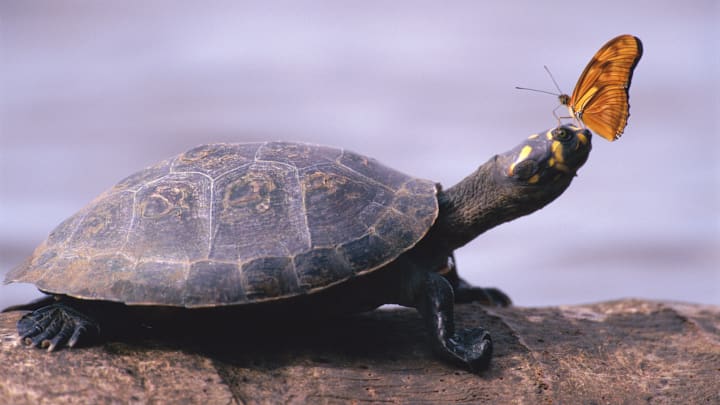"Butterflies?” you’re thinking. “But they’re so … fluttery!” And you’re right. They are very fluttery. But their eating habits are revolting. Here’s a look at some of the the gross things they’ve been known to tuck into.
Mud

Let’s start at the beginning. In kindergarten, you were taught that butterflies are nectar feeders, sipping their sugary meals from flowers. This is still mostly true. But nectar is only one food group, and those other nutrients have to come from somewhere.
After a rainstorm, it’s not uncommon in certain areas to see a whole mess of butterflies sitting on the ground, sucking up mud. This practice is known as “mud-puddling” or simply “puddling,” and scientists believe certain butterfly species do it to round out their salt, nitrogen, protein, and amino acid intake.
Naturally, mud is just the beginning.
Sweat and Tears

If you’ve ever visited a butterfly house, you’ve likely seen some delighted small child with a butterfly on her arm. “He likes me!” she says. Delighted Small Child is mistaken. It’s not her friendship he’s after, but her precious, precious sweat. Or maybe he’s interested in her tears: In 2014, one butterfly was observed drinking the tears of a sunning spectacled caiman, and photo evidence shows they drink the tears of tortoises, too.
Delighted Small Child might have been wrong about the butterfly liking her, but she probably was not mistaken about the butterfly’s sex, however: Most puddlers are males. Scientists believe that for most butterflies, the sodium goes straight to the sperm, which is then given as a “nuptial gift” to the female, giving the future offspring a better chance of surviving.
Urine

Butterflies love urine—“a fact taken advantage of by collectors,” writes the author of the Handbook for Butterfly Watchers. Some species of butterfly will even consume their own bodily fluids: They’ll secrete a liquid onto dried up sweat or a dried puddle of a larger animal’s urine so they can lap up the freshly dissolved minerals.
Blood and Poop

Back to the butterfly house. If Delighted Small Child injures herself, her helpful butterfly buddy will be there to help clean up the blood. By drinking it.
From a butterfly’s perspective, larger animals like humans are probably just big restaurants. And what leftovers! Animal poop is full of all kinds of helpful nutrients, which butterflies will feast upon when given the chance.
Decaying Flesh

You know what else is full of nutrients? Dead bodies!
Rotting animal flesh is a huge butterfly favorite [PDF]—so much so that researchers have begun baiting tropical butterfly traps with shrimp heads, chunks of dead snake, and prawn paste. Texture is key; since butterflies have no teeth, they can essentially only “lick” the rotting meat. “Traps were baited and checked for cycles of five days, with extra bait added each day to ensure a range of decay,” wrote one scientist in her report. Butterfly researchers really don’t get enough credit.
Read More About Insects:
A version of this story originally ran in 2018; it has been updated for 2025.
